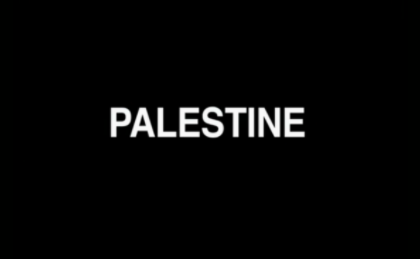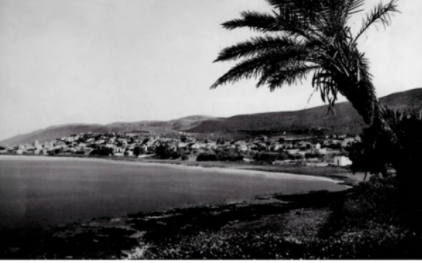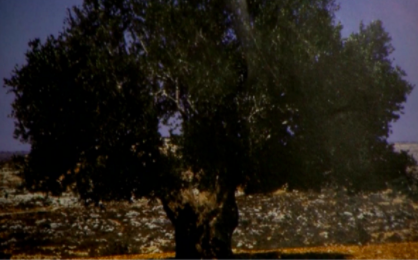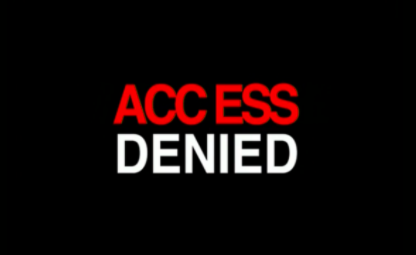Israeli-Palestinian conflict: the ongoing violation of human rights through water control
© Thekla Liebmann
As I started attending a course on Political Dynamics of the Middle East and North Africa at university, my interest in the region and its historical and political complexity was nurtured and intensified by the professor of this course, who I heard speaking once a week for a semester. I never told her, but her classes were the ones that moved me the most and were determinant for the way I started looking at the region and its complex conflicts.
We were already halfway through the semester when we tackled the Israeli-Palestinian conflict in one of our classes. After being acquainted with the Israeli-Palestinian context and the current political debates both within the occupied Palestinian territories and inside Israel, we were invited to attend an online lecture by Ilan Pappé, an Israeli historian, college professor and one of the most prolific writers on this subject. “A History of Modern Palestine: One Land, Two Peoples” and “The Ethnic Cleansing of Palestine” are among his major works.
I started understanding the details of this conflict as I had never been able to do before while I was listening to him explaining how the objectives of 1948 – the year of Israel’s foundation in Palestinian territories – have continued to shape Israel’s actions since 1967. At the time, Israel started occupying the remaining lands of historic Palestine under the logic of the elimination of the native population. The Palestinians use the word Nakba – the Arabic name for “the catastrophe” –, to talk about this period in which they were expelled from their homeland. I also realised that the conflict is much more complex than I have ever thought and that the violation of human rights against Palestinians is undertaken in many ways, every day.
The Israeli control over water resources in Palestine is one of them. Israeli authorities give no opportunity to Palestinians inhabitants to collect water to personal consumption nor for agricultural purposes, since they own Mekorot, the national water company. How can the state of Israel violate human rights in such a way, through the control of the most essential resource to life? How can it continue perpetuating its control over Palestinians without being punished by the international community? The right to water in Palestine will be the core of this brief essay, as TEMA is currently taking a close look at it.
The right to water is a human right, but unfortunately not for all
In 1995, the Oslo II Accord, a peace treaty between Palestinans and Isrealies, was signed and comes with the agreement on Water and Sewage, present in article 40. It entailed the future allocation of water and the development of new water sources, in order to benefit the Palestinians and increase the quantity of water available for them.
It was promised to the Palestinians that they would receive almost 30 million cubic metres of water, but in fact only one third of it was given to them. As Ilan Pappé explains: “even that additional quantity was lost in a policy of permits which controlled and distributed water, as means of reward and punishment in the open mega prison, where the Palestinian’s drinking water networks and ability to drill wells depended on the Israeli good will”.
Before the state of Israel was formally created in 1948, the Zionist movement was already occupying Palestinian territories for long time. In 1919, on the February 3rd, the World Zionist Organisation Statement presented a map of Palestine at the Paris Peace Conference (1919-20), which was basically defined by the water resources. They also stated:
“The economic life of Palestine, like that of every other semi-arid country, depends on the available water supply. It is, therefore, of vital importance not only to secure all water resources already feeding the country, but also to be able to conserve and control them at their sources” (Jewish Virtual Library, n.d., cited by Hagopian, 2016).
By then, most of the people who lived in Palestine were peasants and about 15% of the community depended indirectly on agricultural production, namely traders, mule drivers or middlemen. Therefore, the appropriation and control of the Palestinian territory through water resources was an outset to the Zionist project to be able to take the autonomy of the Palestinian villages away, while maintaining the Palestinian and Jewish markets interdependent from each other. This way, it became easier for the Zionists to proceed with the colonisation process: to forcibly displace Palestinians from their land and to “transform it demographically into a permanent sovereign state for Jews”, as Elaine Hagopian claims.
Today, an estimated 1.2 million residents have no access to running water in the Gaza Strip and, for those who do, up to 97% of the water they receive is too polluted to drink. Also, piped water is reportedly supplied to households for only a few hours every four to five days, according to the United Nations Office for the Coordination of Humanitarian Affairs (OCHA). In the last 15 years, only one in 10 households in Gaza has direct access to safe water, reports UNICEF
According to Amnesty International the southern end of the Coastal Aquifer is the only source of water for the Palestinian inhabitants of the Gaza Strip, but Israel’s extractions affect the water supply available to be extracted in Gaza. Amnesty claims that “most of the water from Wadi Gaza, a stream and surface water source which originates in the Hebron mountains in the West Bank and then flows south-east through Israel and into Gaza, is diverted into a dam in Israel, just before it reaches Gaza”.
In the West Bank, mainly in the Jordan Valley region, Mekorot – the Israeli national water company – operates 42 wells, which mostly supply water for the Israeli settlements. The amount of water that Mekorot sells to the Palestinian water utilities is determined by the Israeli authorities. In 2014, there was no running water in 218 communities in the West Bank. In the city of Hebron, in turn, the daily water consumption is conditioned by the leakage of water resulting from the poor condition of the city pipes, which can’t even be repaired because Israel prevents the efforts of Palestinians to do so.
Indeed, Mekorot’s activity is serving the Zionist colonisation strategy. At the time the company was founded, they drilled dozens of wells, some very close to Palestinian towns and villages. Due to the damages caused by these drillings, the quantity of water that should reach Palestine decreased and even some water sources have dried up.
The agriculture sector has great importance for the limited economy of Palestine, however it is also the sector that requires the biggest amount of water. Therefore, some farmers tried to build storage tanks to collect rainwater, but Israeli authorities destroyed them. And besides the scarcity of water, Palestinians are also faced with a growing problem of pollution: Israeli settlements dump the wastewater (especially industrial waste) into Palestinian lands on purpose, which pollutes both the agricultural lands and groundwater. This directly affects public health in Palestine, as pollution increased the number of infectious diseases and led to an increasing dehydration of patients, because of insufficient water intake and improper care. Some children suffered from poor hygiene; others fell ill. Hospitals couldn’t do much about it either, as the water shortage and the arrival of unsafe water into their pipes could also be felt there.
Finally, we can go back to the questions in the beginning of this article and ask how is it possible that no international actor or law can put an end to the Israeli-Palestinian conflict and that no mechanism is created with the legitimacy to oblige Israel to stop its military occupation of Palestine. To recognize the state of Palestine is not the solution per se. The Hague Convention, of 1907, and the Fourth Geneva Convention, of 1949, are also two major international conventions that deal with the rights and obligations of an occupying power vis-à-vis the local population, and both were signed by Israel. But none of them makes a difference here.
In an interview with Fumaça, Ilan Pappé said:
Peace will not come without a certain Israeli acknowledgement of its criminal policies in 1948, and also I think what we're realising more and more is that ethnic cleansing is going on today. You know, the Palestinians call it in Arabic “al-Nakba al-Mustamira” - the ongoing Nakba. Because they rightly say that even after 1948, the ethnic cleansing of Palestine continues. Sometimes, on a very low level: the expulsion of one Palestinian, or the destruction of one Palestinian home, or just one Palestinian village. But, all in all, from 1948 until 2018, there isn’t one day when some sort of ethnic cleansing is being not performed on the ground. And some sort of mechanism of bringing Israel to justice will be necessary.
Restricting the access to water is also one of the forms through which ethnic cleansing of Palestine is performed. All in all, the Oslo Accords ended up benefiting Israel and institutionalising its system of water control, as well as the exploitation one, and, in the end, denying the right to water to the Palestinians.
±
O conflito israelo-palestiniano: a contínua violação dos direitos humanos através do controlo da água
© Thekla Liebmann
Quando comecei a frequentar a “cadeira” de Dinâmicas Políticas da Região do Médio Oriente e Norte de África na universidade, o meu interesse pela região e pelas suas complexidades histórica e política foi sendo alimentado e intensificado pela professora que a leccionou, a qual ouvi falar uma vez por semana, durante um semestre. Nunca lhe contei, mas foram as suas aulas que mais me motivaram e foram determinantes para a forma como comecei a olhar para a região e para as suas complexidades.
Já estávamos a meio do semestre quando abordámos o conflito israelo-palestiniano numa das nossas aulas. Depois de termos sido familiarizados com o contexto israelo-palestiniano e os debates políticos actuais, tanto dentro dos territórios ocupados da Palestina como dentro de Israel, fomos convidados a assistir a uma palestra online dada por Ilan Pappé, historiador israelita, professor universitário e um dos mais prolíficos escritores sobre este tema. “A History of Modern Palestine: One Land, Two Peoples” e “The Ethnic Cleansing of Palestine” estão entre as suas principais obras.
Foi aí que passei a compreender os pormenores deste conflito como ainda não tinha sido capaz de o fazer antes, enquanto o ouvia explicar como os objectivos de 1948 - o ano da fundação de Israel sobre os territórios palestinianos - continuaram a moldar as acções de Israel desde 1967. Nessa altura, Israel ocupou as restantes terras da Palestina histórica, sob a lógica da eliminação da população nativa. Os palestinianos usam a palavra Nakba – o nome árabe para "a catástrofe" –, para falar deste período em que foram expulsos da sua casa. Percebi também que o conflito é muito mais complexo do que alguma vez pensei e que a violação dos direitos dos palestinianos – que são também direitos humanos – é levada a cabo de muitas maneiras, todos os dias.
O controlo israelita sobre os recursos hídricos na Palestina é uma delas. As autoridades israelitas não dão qualquer oportunidade aos nativos da Palestina de recolher água para consumo pessoal ou para fins agrícolas, uma vez que são detentores da Mekorot, a companhia nacional de água. Como pode Israel violar os direitos humanos desta forma, através do controlo do recurso mais essencial à vida? Como pode continuar a perpetuar o seu controlo sobre os palestinianos sem ser punido pela comunidade internacional? O direito à água na Palestina será o cerne deste breve ensaio, uma vez que a TEMA está agora a analisar este tópico de perto.
O direito à água é um direito humano, mas infelizmente não para todos
Em 1995, o Acordo de Oslo II é assinado e traz consigo o acordo sobre Água e Esgotos, presente no artigo 40. Este implicava o futuro provimento de água e o desenvolvimento de novas fontes hídricas, a fim de beneficiar os palestinianos e aumentar a quantidade de água disponível para eles.
Foi-lhes prometido que iriam receber quase 30 milhões de metros cúbicos de água, mas de facto apenas um terço desta quantidade lhes foi dado. Como Ilan Pappé explica "mesmo essa quantidade adicional foi perdida numa política de licenças que controlava e distribuía água, como meio de recompensa e punição na mega prisão aberta, onde as redes de água potável dos palestinianos e a capacidade de perfurar poços dependiam da boa vontade israelita".
Antes da criação formal do estado de Israel em 1948, o movimento sionista já ocupava há muito tempo os territórios palestinianos. Em 1919, no dia 3 de Fevereiro, a Declaração da Organização Mundial Sionista apresentou um mapa da Palestina na Conferência de Paz de Paris (1919-20) cujas fronteiras foram basicamente definidas pelos recursos hídricos. Declararam também:
"A vida económica da Palestina, como a de qualquer outro país semiárido, depende do abastecimento de água disponível. É, portanto, de vital importância não só assegurar todos os recursos hídricos que já alimentam o país, mas também ser capaz de os conservar e controlar nas suas fontes" (Jewish Virtual Library, n.d., citada por Hagopian, 2016).
Nessa altura, a maioria das pessoas que viviam na Palestina eram camponeses e cerca de 15% da comunidade dependia indirectamente da produção agrícola, nomeadamente os comerciantes, os condutores de mulas de carga ou os intermediários. Por conseguinte, a apropriação e o controlo do território palestiniano através dos recursos hídricos foi o início para o projecto sionista conseguir retirar autonomia às aldeias palestinianas, mantendo os mercados palestiniano e judeu interdependentes um do outro. Desta forma, tornou-se mais fácil para os sionistas prosseguir com o processo de colonização: deslocar à força os palestinianos da sua terra natal e "transformá-la demograficamente num Estado soberano permanente para os judeus", como Elaine Hagopian afirma.
Actualmente, estima-se que 1,2 milhões de habitantes não têm acesso a água corrente na Faixa de Gaza e, para aqueles que o têm, 97% da água que recebem é demasiado poluída para beber. Além disso, de acordo com o Gabinete de Coordenação dos Assuntos Humanitários das Nações Unidas (OCHA), a água canalizada é supostamente fornecida às famílias apenas durante algumas horas, a cada quatro a cinco dias. Nos últimos 15 anos, apenas um em cada 10 agregados familiares em Gaza tinha acesso directo a água potável, de acordo com dados da UNICEF.
Segundo a Amnistia Internacional, o extremo sul do Aquífero Costeiro é a única fonte de água para os habitantes palestinianos da Faixa de Gaza, mas as extracções por parte de Israel afectam o abastecimento de água disponível para ser extraída em Gaza. A Amnistia afirma que "a maior parte da água de Wadi Gaza, um riacho e uma fonte de água superficial que tem origem nas montanhas de Hebron na Cisjordânia e depois corre para sudeste, através de Israel, entrando em Gaza, é desviada para uma barragem em Israel, mesmo antes de chegar a Gaza".
Na Cisjordânia, principalmente na região do Vale do Jordão, a Mekorot - a empresa de água israelita - opera 42 poços, os quais fornecem sobretudo água aos assentamentos israelitas. A quantidade de água que a Mekorot vende às concessionárias de água palestinianas é determinada pelas autoridades israelitas. Em 2014, não havia água corrente em 218 comunidades na Cisjordânia. Na cidade de Hebron, por sua vez, o consumo diário de água é condicionado pelas fugas de água que têm origem no mau estado das condutas da cidade, as quais nem sequer podem ser reparadas, uma vez que Israel o impede de ser feito.
Neste sentido, a actividade de Mekorot está ao serviço da estratégia sionista de colonização. Quando esta companhia foi criada, dezenas de poços foram perfurados; alguns muito próximos de cidades e aldeias palestinianas. Devido aos danos causados por estas perfurações, a quantidade de água que deveria chegar à Palestina diminuiu e algumas fontes de água chegaram mesmo a secar.
Num outro plano, o sector agrícola representa um papel importante na limitada economia da Palestina, sendo também aquele que requer a maior quantidade de água. Deste modo, é sabido que alguns agricultores tentaram construir tanques de armazenamento onde pudessem recolher a água da chuva, mas as autoridades israelitas destruíram-nos. E, além da escassez de água que assola estes territórios, os palestinianos ainda se vêem confrontados com um problema crescente de poluição: os assentamentos israelitas chegaram a despejar águas residuais (nomeadamente resíduos industriais) em terras palestinianas de propósito, o que poluiu não só as terras agrícolas como também os lençóis freáticos.
Isto afectou, e continua a afectar, directamente a saúde pública na Palestina, uma vez que a poluição fez crescer o número de doenças infecciosas e levou a uma desidratação crescente dos doentes, devido à ingestão insuficiente de água e a cuidados de saúde inadequados. Algumas crianças sofreram pela falta de condições de higiene, sendo que outras acabaram por ficar seriamente doentes. Os hospitais, por sua vez, foram igualmente assolados pela escassez de água ou pela chegada de água imprópria para uso ou consumo às suas condutas, não tendo, por isso, conseguido colaborar tanto como deviam.
Para terminar, podemos voltar às perguntas elencadas no início deste artigo e questionarmo-nos novamente como é possível que nenhum actor ou lei internacional consiga pôr fim ao conflito israelo-palestiniano e que nenhum mecanismo seja criado com legitimidade suficiente para obrigar Israel a pôr termo à sua ocupação militar da Palestina. Reconhecer o Estado da Palestina não é a solução em si mesma, se primeiro não se puser termo à ocupação militar. A Convenção de Haia, de 1907, e a Quarta Convenção de Genebra, de 1949, são também duas importantes convenções internacionais que tratam dos direitos e das obrigações de uma potência ocupante perante a população local, e ambas foram assinadas por Israel. Mas nenhuma delas parece fazer a diferença aqui.
Numa entrevista ao Fumaça, Ilan Pappé disse:
“A paz não chegará sem um certo reconhecimento israelita das suas políticas criminosas de 1948, e também acho que o que estamos a perceber cada vez mais é que a limpeza étnica existe ainda hoje. Sabe, os palestinianos chamam-lhe “al-Nakba al-Mustamira”, a continuação da Nakba. Porque eles dizem, e bem, que mesmo depois de 1948, a limpeza étnica da Palestina continua. Por vezes, a um nível muito subtil: [através] da expulsão de um palestiniano, da destruição de uma casa palestiniana ou apenas de uma aldeia palestiniana. Mas, no fundo, de 1948 até 2018, não existe um dia em que algum tipo de limpeza étnica não seja executado no território. E é necessário que algum mecanismo de justiça leve Israel à justiça.”
Restringir ou proibir o acesso à água é também uma das formas através das quais a limpeza étnica da Palestina é conduzida. Tudo somado, os Acordos de Oslo acabaram por beneficiar Israel e institucionalizar o seu sistema de controlo da água, bem como o de exploração, e, enfim, negando o direito à água aos palestinianos.
Bibliography/ Read more:
Amnesty International (2009), Report “Troubled Waters – Palestinians Denied Fair Access to Water. Israel-occupied Palestinian Territories”. Available at: https://www.amnesty.org/download/Documents/48000/mde150272009en.pdf
Fumaça interview to Ilan Pappé about the Israeli occupation of Palestine, 2018. Available at: https://fumaca.pt/entrevista-ilan-pappe-e-a-ocupacao-israelita-da-palestina/
Unicef report. Available at: https://blogs.unicef.org/blog/searching-clean-water-gaza/].
Gaza situation report. Available at: https://www.unrwa.org/newsroom/emergency-reports/gaza-situation-report-220
Hagopian, Elaine (2016), “The Primacy of Water in the Zionist Project”, Arab Studies Quarterly, Vol. 38, No. 4, pp. 700-708.
Kamhawi-Bitar, Nida (2014), Israel’s Obligations Concerning Natural Resources According to the International Law, Palestine-Israel Journal, Vol. 19, n.º 3.
Lein, Yehezkel (2000), “Disputed Waters: Israel’s Responsibility for the Water Shortage in the Occupied Territories”, Ecotheology 9, pp. 68-83.
Interview with Ian Pappe: https://www.youtube.com/watch?v=32667KycvJE
Pappe, Ilan (2004), A History of Modern Palestine, Cambridge: Cambridge University Press.
Pappe, Ilan (2006), The Ethnic Cleansing of Palestine, Oneworld Classics.









